p class ="western"> "The death of one person is a tragedy, the death of millions is just a statistic". Contrary to popular myth, these words never came from Stalin's lips. It is not surprising, however, that they were assigned them to him. The scale of the Soviet dictator's crimes was so enormous that it is difficult to describe and encompass it with numbers. We will try anyway.
Gulag - 60,000,000 victims
It was the most terrifying system of exploitation and extermination, perhaps comparable only to the insanity of the Holocaust. At its peak, there were even several million prisoners in the camps - about five percent of the entire population of the Union of Soviet Socialist Republics.
When trying to estimate the number of victims of the Gulag, one should also remember about those who died during the transport to the labor camps, and those who died after leaving it as a result of complete exhaustion of the organism.
Łagiernik Aleksander Solzhenitsyn estimated that from the beginning of the revolution to 1956 over 60 million citizens of the USSR were killed in the camps . The lion's share fell under the rule of Stalin (the Gulag system started for good in 1923, and after Dzhugashvili's death it was quickly extinguished).
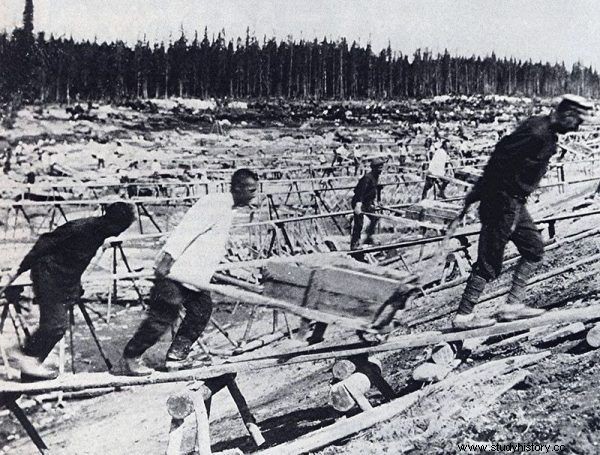
Construction of the Białomorski Canal. According to Solzhenitsyn, up to a quarter of a million victims of Stalinist terror died and died with her (source:public domain).
This shocking figure is questioned by most historians. Let us add, however, that the prisoners of the Gulag were not only citizens of the USSR, but also, among others, millions of German prisoners of war or hundreds of thousands of Poles.
World War II - 27,000,000 casualties
I count on Stalin's account all the victims of World War II on the side of the USSR (both military and civilian), because it was the Molotov-Ribbentrop Pact that led to its outbreak.
For almost two consecutive years, Stalin was a staunch ally of Hitler, enabling him to continue his conquests, while himself seizing eastern Poland, part of Finland, the Baltic states and Romanian Bessarabia. The horribly high Soviet losses during the war (many times higher than the German ones) were primarily caused by contempt of Soviet decision-makers for human life .
In the case of military action, it was equal to a defense strategy of not a step back and the Scorched Earth Directive and in the case of offensive actions - attacking the German positions with successive waves of soldiers (who were "courageous" by the NKVD units firing at them from the rear), without taking into account losses.

Fallen Red Army soldiers. Photo from 1942 (source:Bundesarchiv; photo:Richard Muck; license CC-BY-SA 3.0).
In May 1945, the victorious Stalin was on the lips of the whole world. However, there was also a second medal:
Modern demographers speak of 27 million fatalities, a large proportion of whom were young people, which is the future of the country. Thousands of towns and villages lay in ruins and many people were forced to live in dugouts. Several million injured veterans needed government support - writes Oleg Khlevniuk in the book "Stalin. A new biography ”.
Great Famine - 6,000,000 victims
The New Economic Policy introduced by Lenin in 1921 with elements of the free market, in fact, saved the Bolshevik regime from collapse. In 1929, however, Stalin decided that this "tactical retreat" from the holy "laws of economy" of communism was enough.
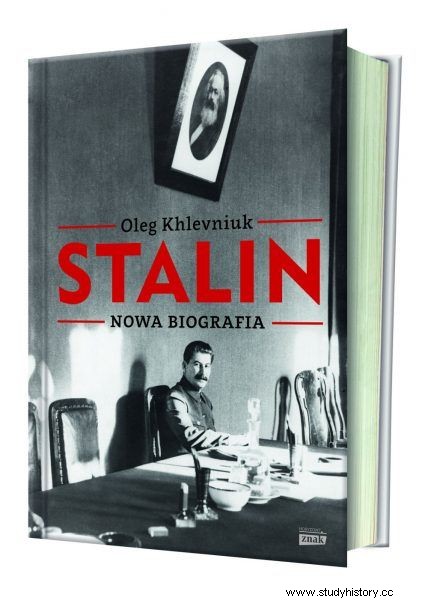
The quotes come from the book "Stalin. A new biography ”by Oleg Khlevniuk, ed. Horizon 2016 sign
He devised a crazy plan to deprive Soviet peasants of all their possessions, incorporate them into collective farms and collectivize all agricultural production. This was to be accompanied by the physical liquidation of the richer peasants (kulaks) as a social class.
Soviet citizens did not agree with the leader's view of the superiority of collective agriculture over individual agriculture. In 1930 alone, there were fourteen thousand revolts, riots and mass demonstrations nationwide.
Stalin decided to crush the resistance in such a cruel way that world history had not yet known:
(...) the Stalinist government used starvation as a method of "punishment" for the countryside. All possibilities to alleviate the situation, such as buying grain abroad, have been rejected. Starving peasants were expropriated from their last food supplies - describes Oleg Khlevniuk.
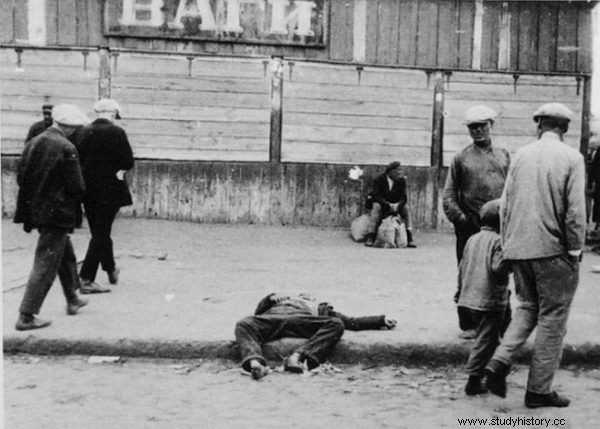
Everyday life in the Ukrainian Kharkiv in 1933 - death by starvation (source:public domain).
As a result of the Great Famine, more than 6 million people died, mainly in Ukraine. The author of the new biography of Stalin writes:
(...) secret party documents - they are filled with testimonies of universal cannibalism. Mothers murdered their children, and mad activists robbed and tormented the population.
Famine 1945–1947 - 1,500,000 victims
The post-war collapse of collectivized agriculture, its grossly low efficiency and the weakness of the food distribution system led to the deaths of another hundreds of thousands of people. It was only in 1948 that the yields began to approach the pre-war level, which is also far from the optimum. Before this happened, famine had killed 1.5 million people .
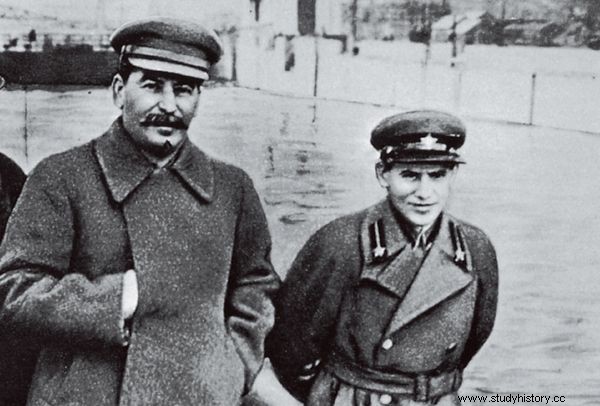
Co-founders of the Great Terror. Stalin and Nikolai Yezhov, 1938 (source:public domain).
Great Terror 1936-1938 - 800,000 victims
In 1936, Stalin found a man who was to carry out the Great Purge and then take all its odium on himself. Two years of rule in the NKVD of "Bloody Dwarf" by Nikolai Yezhov resulted in almost a million executions.
The order accepted by the Politburo imposed an obligation on individual Soviet republics and oblasts to eliminate a specific number of enemies and saboteurs. As Khlevniuk adds:
(...) the order allowed flexibility - local officials had the right to ask Moscow to increase the allowed number of arrests and executions. (...) With the encouragement of Moscow the original plan to destroy the "enemies" was fulfilled several times above the norm .
Introducing communism in Central and Eastern Europe - 400,000 victims
The introduction of communism after World War II in the countries of Central and Eastern Europe:in Poland, East Germany, Czechoslovakia, Hungary, Romania, Bulgaria and Albania, cost the lives of several hundred thousand people.

W. Churchill, F.D. Roosevelt and Stalin at the Yalta Conference, which sealed the post-war fate of Central and Eastern Europe. One of its effects was the death of approx. 400,000 people. people in the new countries of "people's democracy" (source:public domain).
It is estimated that around 400,000 victims were killed. First of all, members of the armed underground and political opponents of the communists were liquidated .
Polish NKVD operation - 200,000 victims
The operation to liquidate people of Polish nationality living in the territory of the USSR, carried out during the years of the Great Terror, resulted in the death of 200,000 of our countrymen. At least such estimates are given in his book Forgotten Genocide. Poles in the State of Stalin ” Nikolai Ivanov.
The only criterion of execution was the Polish nationality of the victims, hence it is entitled to classify the entire action as planned genocide . It was the largest such operation of the NKVD, programmatically directed against members of a particular ethnic group.
Katyn massacre - 22,000 victims
Signed by Stalin and other members of the Political Bureau, a piece of paper decided to execute Polish officers without summoning the convicts, without presenting charges, without a decision to end the investigation and indictment.
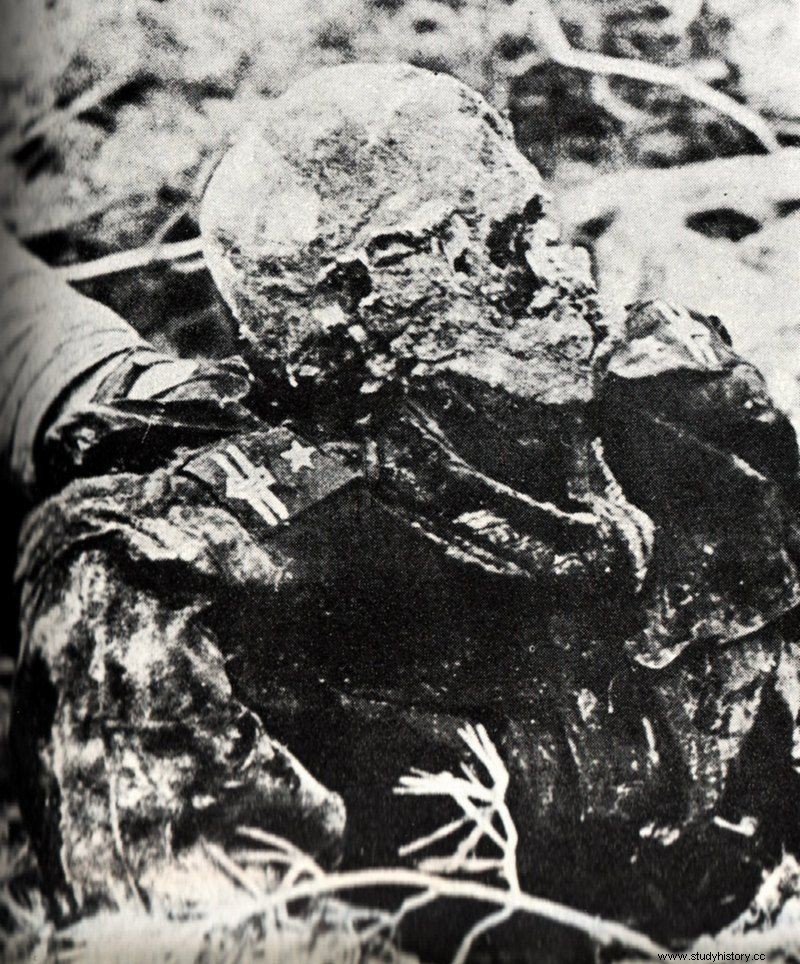
Photo of the body of one of the Polish officers murdered by the NKVD. They were taken during the exhumation carried out by the Germans in 1943 (source:public domain).
The execution was carried out by the NKVD with shots to the back of the head . The murder of Polish officers in Katyn was a crime with features of genocide, which Russia persistently denies to this day.
Hunt for the opposition in the Central Committee after Lenin's death - 1,000 victims
In 1925, Stalin began a regular hunt for his political opponents. They were deprived of their party membership, sent to the provinces, and over time physically eliminated. The leading opposition leaders - Trotsky, Zinoviev, Kamenev and Radek - had all been liquidated by 1940.
The hunt for counter-revolution in Tsaritsyno - 1,000 casualties
The victims of the Bolshevik revolution and the civil war (and there could have been up to 9 million - this is how many Richard Pipes counted) are counted on Lenin's account.
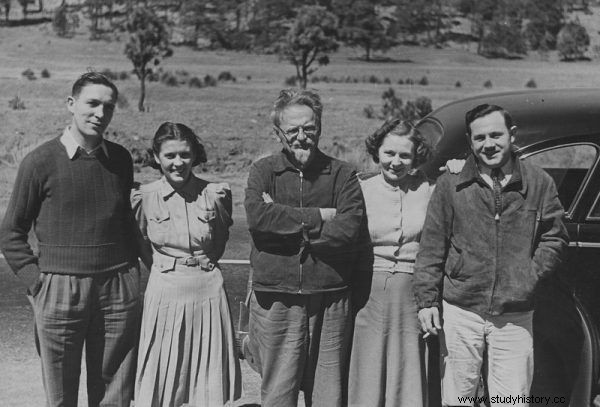
Even leaving for the other end of the world did not protect Stalin from revenge. Lev Trotsky found this out. In a photo taken in 1940, Trotsky and his American followers (source:public domain).
And yet the shared responsibility of his closest associate is indisputable. How Stalin blindly supported Lenin's bloody policy is evidenced, for example, by his stay in Tsaritsyn (later Stalingrad) in 1918. He was sent there for several months on a mission to get grain from southern Russia.
It was the first time in his life that Stalin felt what it was like to have absolute power. Effect? In one week of September alone, he ordered 103 executions by tracking down imaginary counter-revolutionary conspiracies. When, terrified by the scale of repression (even by the conditions of the cruel civil war), his comrades complained to Lenin, he first doubted himself, but then agreed with his most knowledgeable student.
TOTAL:95,924,000 victims (say ninety-five million nine hundred and twenty-four thousand victims)
The number given may be shocking. Especially Solzhenitsyn's estimates have been repeatedly questioned by historians.

Learn new facts about the life and politics of the dictator. "Stalin. A new biography ”by Oleg Khlevniuk, ed. Horizon 2016 sign
It may also be debatable to add the victims of World War II to the "Stalin's account", although there is no doubt that he is directly responsible for its outbreak, as well as the civil and military losses of the USSR, many times exceeding the losses of other countries.
Unbelievable number?
One hundred million victims of communism were counted by the famous French historian Stephane Courtois - most of them victims of the Chinese version of utopia. Iosif Dyadkin in his book "Unnatural Deaths in USSR 1928 - 1954" indicates about 60 million unnatural deaths in the USSR only during this period.
And even the usually cautious Norman Davies in his "Europe ..." talks about 50 million killed in the years 1924-1953, but excluding the victims of World War II (after adding the official figure of 27 million killed, we already reach the level of almost 80 million ...).
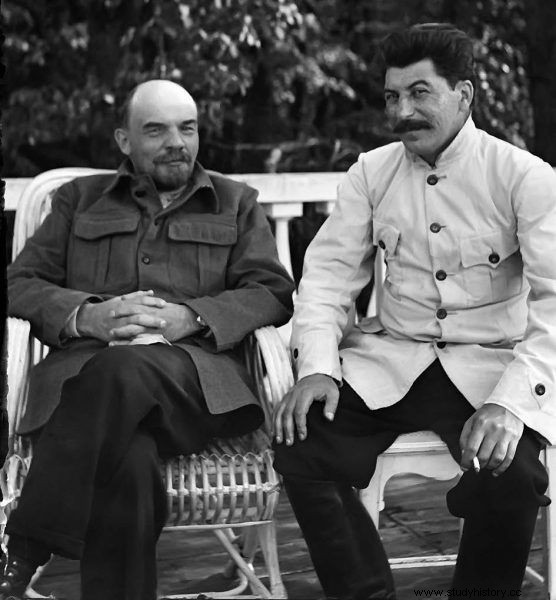
Włodzimierz Lenin and Józef Stalin. Great teachers of mankind from terror and genocide. Picture from Oleg Khlevniuk's book “Stalin. New biography ”(Znak Horyzont 2016).
I did not take into account the victims of the Bolshevik revolution, the civil war in Russia or the Soviet-Polish war. We also do not know how many people died as a result of the displacement of entire nations, which took place on the orders of Stalin.
The number given by me could as well be higher and exceed the symbolic one hundred million. Anyway, Józef Wissarionowicz Stalin has several times more victims than Adolf Hitler . The awareness of this fact, especially in Western Europe, does not seem to be particularly high.
Bibliography:
- Norman Davies, Europe. A historian's trial with history , Character 2002.
- Norman Davies, Europe is fighting 2008 mark.
- Milovan Djilas, Conversations with Stalin, Iskry 1991.
- Orlando Figes, Whispers. Life in Stalinist Russia, Magnum 2008.
- Nikolai Ivanov, Forgotten genocide. Poles in the state of Stalin, Horizon 2015 sign.
- Oleg Khlevniuk, Stalin. New biography, Horizon 2016 sign.
- Collective work, The Black Book of Communism. Crimes, terror, persecution , Prószyński i S-ka, 1999.
- Aleksander Solzhenitsyn, The Gulag Archipelago, Rebis 2013.
